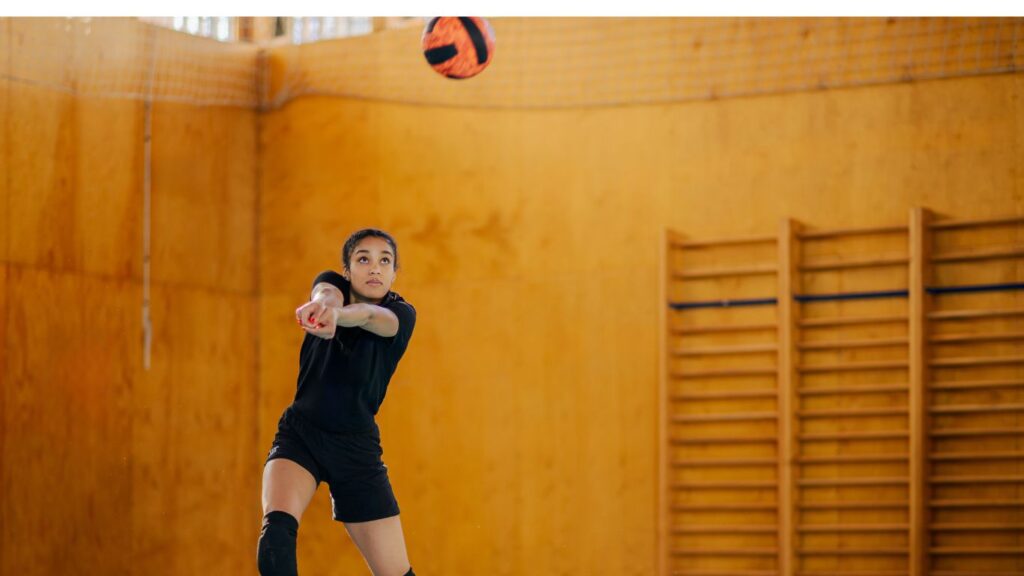Improving your volleyball skills can seem daunting, especially if you’re new to the sport. However, you can make significant progress with structured training and dedicated practice. This guide will focus on improving three fundamental volleyball skills: serving, setting, and spiking. We’ll provide effective drills, a structured progression plan, and insights into the importance of mental training.
Serving
Key Techniques
- Consistent Toss: The toss is crucial for a booming serve. Practice tossing the ball consistently to the same height and position.
- Contact Point: Work on striking the ball with the correct part of your hand (usually the heel of your palm) to ensure better control and power.
Effective Drills

- Float Serve Drill: Focus on hitting the ball so that it doesn’t spin, making it harder for the opponent to predict its trajectory.
- Target Serving: Set up targets at various distances on the court and practice hitting them consistently.
- Distance Variations: Serve from different positions on the court to improve accuracy and adaptability.
Setting
Key Techniques
- Hand Positioning: Ensure your hands are correctly positioned (forming a triangle with your thumbs and forefingers). This helps in making clean and accurate sets.
- Ball Control: Develop a soft touch to control the ball effectively.
Effective Drills
- Partner Drills: Practice setting with a partner to improve timing and accuracy.
- Wall Setting: Stand a few feet from a wall and practice setting against it to refine your technique.
- Setting in Pairs Exercise: Fast-paced setting drills with a partner to work on quick, precise sets.
Spiking
Key Techniques
- Approach: Your approach should be explosive and timed correctly to maximize jump height and power.
- Contact: Focus on hitting the ball at its highest point with the full extension of your arm.
Effective Drills

- Approach and Hit Drill: Practice the strategy, jump, and spike technique.
- Blocker vs. Hitter: Work on hitting against a blocker to simulate real-game scenarios.
- Plyometrics: Incorporate plyometric exercises to increase your jump height and power.
Structured Progression Plan
Initial Focus (Weeks 1-2)
- Serving: Master consistent toss and contact.
- Setting: Work on hand positioning and essential ball control.
- Spiking: Practice approach technique and timing.
Skill Building (Weeks 3-6)
- Serving: Introduce serving targets at varying distances, focusing on accuracy.
- Setting: Refine hand positioning and introduce partner drills for timing.
- Spiking: Focus on power and speed in approach and hit drills.
Advanced Techniques (Weeks 7-10)
- Serving: Master the float serve technique.
- Setting: Incorporate the “Setting in Pairs” exercise for quick, precise sets.
- Spiking: Work on jump height and power with plyometric exercises.
Consistency and Accuracy (Weeks 11-14)
- Serving: Consistently hit targets from different positions on the court.
- Setting: Improve consistency and accuracy in setting drills.
- Spiking: Focus on hitting with accuracy and power in game-like scenarios.
Game Simulation (Weeks 15-18)
- Serving: Practice serving under pressure in game simulations.
- Setting: Work on decision-making and quick sets in game-like situations.
- Spiking: Incorporate “Blocker vs. Hitter” drills for realistic game scenarios.
Evaluation and Refinement (Weeks 19-20)
- Review individual progress and focus on areas that need improvement.
- Continue to refine technique and strategy in all three skills.
- Prepare for team play by focusing on communication and coordination.
Mental Training
Mental training is essential in volleyball improvement as it directly impacts an athlete’s performance, resilience, and ability to handle pressure.
Techniques and Importance

- Visualization: Imagining successful serves, sets, and spikes to enhance muscle memory and confidence on the court.
- Goal Setting: Establishing short- and long-term goals for skill improvement and match performance, fostering motivation and focus.
- Positive Self-Talk: Encouraging oneself with positive affirmations can help one maintain confidence and overcome self-doubt during challenging moments in a game.
- Breathing and Relaxation Techniques: Using controlled breathing and relaxation exercises to manage pre-game nerves and stay calm under pressure.
- Mental Rehearsal: Mentally rehearsing strategies and game situations to prepare for the unexpected and make quick, effective decisions on the court.
- Focus and Concentration Drills: Practicing selective attention to stay focused on the game plan and block out distractions.
- Resilience Training: Building mental toughness and the ability to bounce back from mistakes, setbacks, or losses with a positive, growth-oriented mindset.
By integrating these physical and mental training techniques into your routine, you’ll be well on your way to becoming a proficient volleyball player. Consistency and dedication are crucial to improvement, so stick with your training plan and enjoy the journey!









